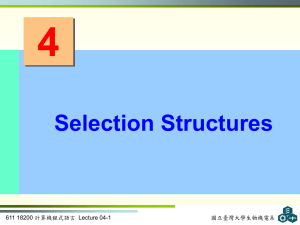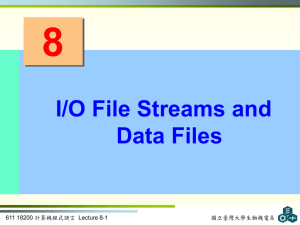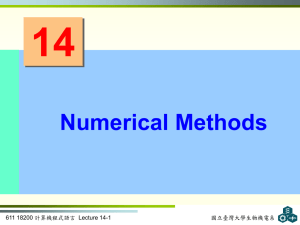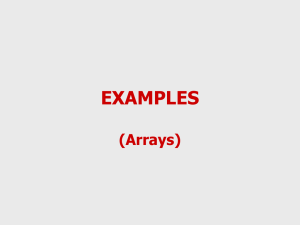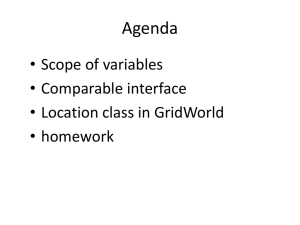Class
advertisement
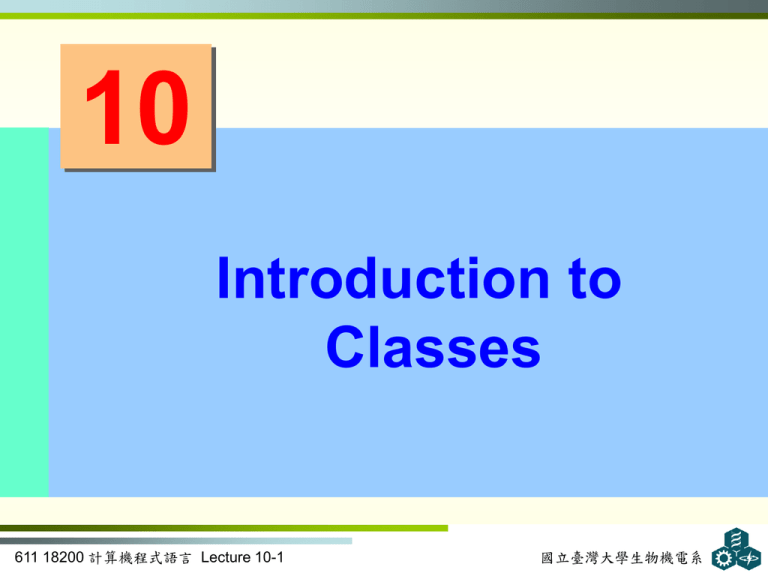
10
Introduction to
Classes
611 18200 計算機程式語言 Lecture 10-1
國立臺灣大學生物機電系
Contents
• Abstract data types in C++ (Classes)
• Constructors
• A case study involving constructing a room
object
• Object identification and the Unified Modeling
Language (UML)
• Common programming errors
611 18200 計算機程式語言 Lecture 10-2
國立臺灣大學生物機電系
Abstract Data Types in C++ (Classes)
• Procedural, hybrid, and pure object-oriented
languages
– Pure object-oriented language: Smalltalk, Eiffel
– C++ is an object-oriented hybrid language.
• An object oriented approach fits graphically
windowed environments
• Abstract data types: Central to creation of objects;
a user defined data type rather than a built-in data
type
611 18200 計算機程式語言 Lecture 10-3
國立臺灣大學生物機電系
Abstract Data Types
• Data type: Combination of data and associated
operations
• A data type defines both the types of data and
the types of operations that can be performed
on the data
– Data type = Allowable Data Values + Operational Capabilities
611 18200 計算機程式語言 Lecture 10-4
國立臺灣大學生物機電系
Abstract Data Types
• Abstract data type (ADT): User defined type
that specifies both a type of data and the
operations that can be performed on it
– User defined types are required when you want
to create objects that are more complex than
simple integers and characters
• Data structure: How data is stored
• Class: C++ name for an abstract data type
611 18200 計算機程式語言 Lecture 10-5
國立臺灣大學生物機電系
Class Construction
• Two components:
– Declaration section: Declares data types and
function for class
– Implementation section: Defines functions
whose prototypes were declared in declaration
section
• Class members:
– Data members (instance variables)
– Member functions
611 18200 計算機程式語言 Lecture 10-6
國立臺灣大學生物機電系
Class Construction
// class declaration section
class classname
{
data members
// the variables
function members // prototypes
};
// class implementation section
function definitions
611 18200 計算機程式語言 Lecture 10-7
國立臺灣大學生物機電系
Class Construction
• Example of class declaration section:
class Date
{
private:
int month;
int day;
int year;
public:
Date(int = 7, int = 4, int = 2006);
void setDate(int, int, int);
void showDate(void);
};
// this is a declaration –
// don't forget the semicolon
611 18200 計算機程式語言 Lecture 10-8
國立臺灣大學生物機電系
Class Construction
• Declaration section of class definition
– Enclosed in braces
– Includes variables (data members) and function
declarations
– Keywords private and public: Define access
rights
• private: Class members (month, day, and year)
can only be accessed using class functions
– Enforces data security (data hiding)
• public: class members (functions Date(),
setDate(), showDate() can be used outside of
the class
611 18200 計算機程式語言 Lecture 10-9
國立臺灣大學生物機電系
Class Construction
• Constructor function: Initializes class data
members with values
– Constructor function (Date()) has same name
as the class
– Default values for constructor are 7, 4, 2006
– Constructor function has no return type (a
requirement for this special function)
• Two remaining member functions: setDate()
and showDate() declared as returning no
value (void)
611 18200 計算機程式語言 Lecture 10-10
國立臺灣大學生物機電系
Class Construction
• Implementation section of class definition
– Functions: Defined same as other C++ functions
but also includes scope resolution operator
• To identify function as member of class
– Implementation and declaration sections declare
a class
• Variables of the class (objects) must still be
defined
611 18200 計算機程式語言 Lecture 10-11
國立臺灣大學生物機電系
Class Construction
Example: Creation of objects of Date class in
main() function of Program 10.1
int main()
{
Date a, b, c(4,1,2000); // declare 3 objects
b.setDate(12,25,2006); // assign values to b's
// data members
cout << endl;
a.showDate();
// display object a's values
b.showDate();
// display object b's values
c.showDate();
// display object c's values
cout << endl;
return 0;
}
611 18200 計算機程式語言 Lecture 10-12
國立臺灣大學生物機電系
Class Construction
• Description of main():
– Three objects of class Date defined
– Constructor function: Date(), automatically
called
• Memory allocated for each object
• Data members of the objects initialized
– Object a: No parameters assigned therefore
defaults are used:
a.month = 7
a.day = 4
a.year = 2005
611 18200 計算機程式語言 Lecture 10-13
國立臺灣大學生物機電系
Class Construction
• Description of main(): (continued)
– Notation to create objects:
objectName.attributeName
– Object b: No parameters assigned, same defaults
used
– Object c: Defined with arguments 4, 1, and 1998
• Three arguments passed into constructor function
resulting in initialization of c’s data members as:
c.month = 4
c.day = 1
c.year = 2000
611 18200 計算機程式語言 Lecture 10-14
國立臺灣大學生物機電系
Class Construction
• Description of main(): continued
– All function of class Date are public, therefore
• b.setDate(12, 25, 2006) is a valid statement
inside main() function
• Calls setDate() function with arguments 12 ,25,
2006
– Important distinction: Data members of class
Date are private
• The statement b.month = 12 is invalid in main()
611 18200 計算機程式語言 Lecture 10-15
國立臺灣大學生物機電系
Class Construction
• Description of main(): continued
– Last three statements in main() call showDate()
to operate on a, b, and c objects
• Calls result in output displayed by Program 10.1
The date is 07/04/06
The date is 12/25/07
The date is 04/01/98
– The statement cout << a; is invalid within
main()
• cout does not know how to handle an object of
class Date
611 18200 計算機程式語言 Lecture 10-16
國立臺灣大學生物機電系
Class Construction
Program 10.1
#include <iostream>
#include <iomanip>
using namespace std;
// class declaration
class Date
{
private:
int month;
int day;
int year;
public:
Date(int = 7, int = 4, int = 2005); // constructor
void setDate(int, int, int); // member function to copy a date
void showDate();
// member function to display a date
};
611 18200 計算機程式語言 Lecture 10-17
國立臺灣大學生物機電系
Class Construction
Program 10.1 (Continued)
// implementation section
Date::Date(int mm, int dd, int yyyy)
{
month = mm;
day = dd;
year = yyyy;
}
void Date::setDate(int mm, int dd, int yyyy)
{
month = mm;
day = dd;
year = yyyy;
return;
}
611 18200 計算機程式語言 Lecture 10-18
國立臺灣大學生物機電系
Class Construction
Program 10.1 (Continued)
void Date::showDate()
{
cout << "The date is ";
cout << setfill('0')
<< setw(2) << month << '/'
<< setw(2) << day << '/'
<< setw(2) << year % 100; // extract last 2 year digits
cout << endl;
return;
}
611 18200 計算機程式語言 Lecture 10-19
國立臺灣大學生物機電系
Class Construction
Program 10.1 (Continued)
int main()
{
Date a, b, c(4,1,2000); // declare 3 objects
b.setDate(12,25,2006);
a.showDate();
b.showDate();
c.showDate();
//
//
//
//
assign values to b's data members
display object a's values
display object b's values
display object c's values
cout << endl;
return 0;
}
611 18200 計算機程式語言 Lecture 10-20
國立臺灣大學生物機電系
Terminology
• Class: Programmer-defined data type
• Objects (instances): Created from classes
– Relation of objects to classes similar to relation of
variables to C++ built-in data types
• int a;
• Date a;
// a is a variable of type integer
// a is an object of class Date
– Instantiation: Process of creating a new object
• Creates new set of data members belonging to
new object: Determines the object’s state
611 18200 計算機程式語言 Lecture 10-21
國立臺灣大學生物機電系
Terminology
• Interface: Part of class declaration section
– Includes:
• Class’s public member function declarations
• Supporting comments
• Implementation: Consists of:
– Implementation section of class definition
• Private member functions
• Public member functions
– Private data members from class declaration section
611 18200 計算機程式語言 Lecture 10-22
國立臺灣大學生物機電系
Terminology
• Information hiding:
– Internal construction of class is not relevant to
programmer who just wishes to use class
– Implementation can and should be hidden from
all users
• Ensures that class is not altered or compromised
in any way
– Information needed by programmer to use class
is provided by interface
611 18200 計算機程式語言 Lecture 10-23
國立臺灣大學生物機電系
Constructors
• A function that has same name as its class
– Multiple constructors can be defined for a class
• Each must be distinguishable by the number and
types of its parameters
• This is an example of function overloading
– If no constructor function is written, compiler
assigns default constructor
• Purpose: Initialize a new object’s data members
– May perform other tasks
611 18200 計算機程式語言 Lecture 10-24
國立臺灣大學生物機電系
Constructors
• Format: Same name as class to which it
belongs
– Must have no return type (not even void)
• Default constructor: Does not require
arguments when called
– Two cases:
• No parameters declared
– As with compiler-supplied default constructor
• Arguments have already been given default values
in valid prototype statement:
– Date (int = 7, int = 4, int = 2005)
– Declaration Date a; initializes the a object with
default values: 7, 4, 2006
611 18200 計算機程式語言 Lecture 10-25
國立臺灣大學生物機電系
Constructors
• Sample class declaration:
class Date
{
private:
int month, day, year;
public:
void setDate(int, int, int);
void showDate()
};
611 18200 計算機程式語言 Lecture 10-26
國立臺灣大學生物機電系
Constructors
• No constructor has been included
– Compiler assigns a do-nothing default
constructor equivalent to: Date (void) { }
• This constructor expects no parameters, and has
an empty body
611 18200 計算機程式語言 Lecture 10-27
國立臺灣大學生物機電系
Constructors
Constructor Format
classname::classname(parameter list)
{
// function body
}
611 18200 計算機程式語言 Lecture 10-28
國立臺灣大學生物機電系
Constructors
Use of constructor in main() - Program 10.2
int main()
{
Date a;
Date b;
Date c (4,1,2006);
return 0;
}
611 18200 計算機程式語言 Lecture 10-29
// declare an object
// declare an object
// declare an object
國立臺灣大學生物機電系
Constructors
Program 10.2
#include <iostream>
using namespace std;
// class declaration section
class Date
{
private:
int month;
int day;
int year;
public:
Date(int = 7, int = 4, int = 2005);
};
611 18200 計算機程式語言 Lecture 10-30
// constructor
國立臺灣大學生物機電系
Constructors
Program 10.2 (Continued)
// implementation section
Date::Date(int mm, int dd, int yyyyy)
{
month = mm;
day = dd;
year = yyyyy;
cout << "Created a new data object with data values "
<< month << ", " << day << ", " << year << endl;
}
int main()
{
Date a;
// declare an ojbect
Date b;
// declare an object
Date c(4,1,2006); // declare an object
return 0;
}
611 18200 計算機程式語言 Lecture 10-31
國立臺灣大學生物機電系
Constructors
Output from Program 10.2
Created a new data object with data values 7, 4, 2005
Created a new data object with data values 7, 4, 2005
Created a new data object with data values 4, 1, 2006
611 18200 計算機程式語言 Lecture 10-32
國立臺灣大學生物機電系
Calling Constructors
• Constructors are called when an object is
created
• Declaration can be made in a variety of ways
– Date c(4,1,2006);
– Date c = Date(4,1,2006);
– Date c = 8;
• An object should never be declared with empty
parentheses
– Date a();
• Not the same as the declaration Date a;
• Does not result in an object being created
611 18200 計算機程式語言 Lecture 10-33
國立臺灣大學生物機電系
Overloaded and Inline Constructors
• Primary difference between a constructor and
other user-written functions is how the
constructor is called
– Constructors are called automatically each time
an object is created
– Most other functions must be called explicitly by
name
• Inline functions are functions defined in the
class declaration section
611 18200 計算機程式語言 Lecture 10-34
國立臺灣大學生物機電系
Destructors
• Destructor functions: Counterpart to the
constructor functions
• Destructors:
– Are functions with the same name as
constructors but are preceded with a tilde (~)
• For the Date class the destructor name is
~Date()
– Take no parameters and return no values
• There can only be one destructor per class
611 18200 計算機程式語言 Lecture 10-35
國立臺灣大學生物機電系
Destructors
• Destructors:
– Called automatically when an object goes out of
existence
– Clean up any undesirable effects the object
might leave, such as releasing memory stored in
a pointer
611 18200 計算機程式語言 Lecture 10-36
國立臺灣大學生物機電系
A Case Study: Constructing a Room Object
• Applying your knowledge of classes: Create a
class from which room objects can be created
• Room’s floor area must be calculated for any
size room when its length and width are known
– For modeling purposes, assume every room is
rectangular
611 18200 計算機程式語言 Lecture 10-37
國立臺灣大學生物機電系
A Case Study: Constructing a Room Object
• Coding the solution
class RoomType
{
// data declaration section
private:
double length; // declare length as a double variable
double width;
// declare width as a double variable
public:
RoomType(double = 0.0, double = 0.0);
// the constructor's declaration
// statement
void showRoomValues();
void setNewRoomValues(double, double);
void calculateRoomArea();
};
611 18200 計算機程式語言 Lecture 10-38
國立臺灣大學生物機電系
A Case Study: Constructing a Room Object
RoomType::RoomType(double l, double w) // this is a constructor
{
length = l;
width = w;
cout << "Created a new room object using the default constructor.\n\n";
}
void RoomType::showRoomValues()
// this is an accessor
{
cout << " length = " << length
<< "\n
width = " << width << endl;
}
void RoomType::setNewRoomValues(double l, double w)
{
length = l;
width = w;
}
void RoomType::calculateRoomArea()
{
cout << (length * width);
}
611 18200 計算機程式語言 Lecture 10-39
// this is a mutator
// this performs a calculation
國立臺灣大學生物機電系
A Closer Look: Object Identification and
the Unified Modeling Language (UML)
• When solving any problem, it is often helpful to
start by creating a diagram or map or devising a
theoretical analogy for the problem you are
trying to solve
• The first step in constructing an object-based
program is developing an object-based model
of the program
611 18200 計算機程式語言 Lecture 10-40
國立臺灣大學生物機電系
A Closer Look: Object Identification and
the Unified Modeling Language (UML)
Figure 10.1 A class is a programming-language description of a model
611 18200 計算機程式語言 Lecture 10-41
國立臺灣大學生物機電系
Representing Problems with Models
• A model is a representation of a problem
• First step in creating an object-based model is
to begin “thinking in objects”
• Objects can be modeled by two basic
characteristics
– Attributes define the properties of interest
– Behaviors define how the object reacts to its
environment
611 18200 計算機程式語言 Lecture 10-42
國立臺灣大學生物機電系
Representing Problems with Models
• Two steps to designing and developing an
object-oriented program
– Identify the required objects
– For each object
• Identify the attributes of interest
• Indentify the behaviors (operations) of interest
• Object description diagram: Summarizes
initial results of the two steps in a form that can
be translated into a programming language
611 18200 計算機程式語言 Lecture 10-43
國立臺灣大學生物機電系
Representing Problems with Models
Object: A coin
Attributes: Side (head or tail)
Behavior: Landing with heads up or tails up
Figure 10.2 An initial object diagram
611 18200 計算機程式語言 Lecture 10-44
國立臺灣大學生物機電系
Representing Problems with Models
• Unified Modeling Language (UML) is a widely
accepted technique for developing object
oriented programs
– A program-modeling language
– Uses diagrams and techniques that are easy to
understand and support all the features required
to implement an object-oriented design
611 18200 計算機程式語言 Lecture 10-45
國立臺灣大學生物機電系
Representing Problems with Models
• Designing an object-oriented program requires
understanding and specifying
– The objects in the system
– What can happen to these objects
– When something can happen to these objects
611 18200 計算機程式語言 Lecture 10-46
國立臺灣大學生物機電系
Representing Problems with Models
• UML provides seven diagram types
–
–
–
–
–
–
–
–
Class
Object
State
Sequence
Activity
Use case
Component
Deployment
611 18200 計算機程式語言 Lecture 10-47
國立臺灣大學生物機電系
Class and Object Diagrams
• Class diagrams are used to describe classes
and their relationships
• Object diagrams are used to describe objects
and their relationships
• Both classes and objects are represented with
a diagram consisting of a box
• In class diagrams, the class name is in bold text
and centered at the top of the box
• In object diagrams, the object’s name is also
centered at the top of the box, underlined
611 18200 計算機程式語言 Lecture 10-48
國立臺灣大學生物機電系
Class and Object Diagrams
Figure 10.3 Class and object representations
611 18200 計算機程式語言 Lecture 10-49
國立臺灣大學生物機電系
Class and Object Diagrams
Figure 10.5 Including attributes in UML class and object diagrams
611 18200 計算機程式語言 Lecture 10-50
國立臺灣大學生物機電系
Class and Object Diagrams
• Visibility defines where an attribute can be seen
– Private
• Can be used on in its defining class
• Cannot be accessed by other classes directly
• Indicated by a minus (-) sign in front of attribute name
– Public
• Used in any other class
• Indicated by a plus (+) sign in front of attribute name
– Protected
• Available to derived classes
• Neither plus nor minus sign in front of attribute name
611 18200 計算機程式語言 Lecture 10-51
國立臺灣大學生物機電系
Class and Object Diagrams
Figure 10.6 A class with attributes
611 18200 計算機程式語言 Lecture 10-52
國立臺灣大學生物機電系
Class and Object Diagrams
• Operations are transformations that can be
applied to attributes and are coded as C++
functions
• Operation names are listed below attributes
and separated from them by a line
611 18200 計算機程式語言 Lecture 10-53
國立臺灣大學生物機電系
Class and Object Diagrams
Figure 10.7 Including operations in class diagrams
611 18200 計算機程式語言 Lecture 10-54
國立臺灣大學生物機電系
Relationships
• In addition to describing classes and objects,
UML class and object diagrams show the
relationships between classes and/or objects
• Associations between classes are typically
signified by phrases such as “is related to,” “is
associated with,” “has a,” “is employed by,”
“works for”, and others
• Relationship is indicated by a straight line
connecting two classes or objects
• Multiplicity: Idea of “zero-or-more” is indicated
by the * symbol
611 18200 計算機程式語言 Lecture 10-55
國立臺灣大學生物機電系
Relationships
Figure 10.8 An association
611 18200 計算機程式語言 Lecture 10-56
國立臺灣大學生物機電系
Relationships
Table 10.2 UML Association Notation
611 18200 計算機程式語言 Lecture 10-57
國立臺灣大學生物機電系
Relationships
• An aggregation is a type of association in
which one class or object, referred to as the
whole element, “consists of” or “is composed of”
other classes or objects
Figure 10.9 Single-level aggregation
611 18200 計算機程式語言 Lecture 10-58
國立臺灣大學生物機電系
Relationships
• The hollow diamond symbol indicates that the
parts can still exist independent of the whole to
which they belong
• A solid diamond symbol indicates that the
component parts are intrinsic members of the
whole
• Inheritance is a relationship between a class
and a derived version of the class
611 18200 計算機程式語言 Lecture 10-59
國立臺灣大學生物機電系
Relationships
Figure 10.10 Another single-level aggregation
611 18200 計算機程式語言 Lecture 10-60
國立臺灣大學生物機電系
Common Programming Errors
• Failing to terminate class declaration section
with semicolon
• Including return type with constructor’s
prototype or failing to include return type with
other functions’ prototypes
• Using same name for a data member as for a
member function
• Defining more than one default constructor
• Forgetting to include class name and scope
operator, ::, in the function header
611 18200 計算機程式語言 Lecture 10-61
國立臺灣大學生物機電系
Summary
• A class
– Is a programmer-defined data type
– Consists of a declaration and implementation
section
• Class functions can be written inline or included
in the class implementation section
• A constructor function is a special function that
is called automatically each time an object is
declared
– If no constructor is declared, compiler supplies a
default
611 18200 計算機程式語言 Lecture 10-62
國立臺灣大學生物機電系
Summary
• Default constructor is the term for any constructor that
does not require arguments
– Each class can have only one default constructor
• Objects are created by using a C++ or C style
declaration:
className list-of-objectNames
(list of initializers);
• Constructors can be overloaded
– If a constructor is defined for a class, a user-defined
default constructor should also be written, as
compiler will not provide one
611 18200 計算機程式語言 Lecture 10-63
國立臺灣大學生物機電系
Summary
• A destructor function is called each time an
object goes out of scope
• Destructors have the same name as their class,
but preceded with a tilde (~)
• There is only one destructor per class
• Destructor takes no arguments and returns no
value
• If a user-defined destructor is not included in a
class, compiler provides a do-nothing
destructor
611 18200 計算機程式語言 Lecture 10-64
國立臺灣大學生物機電系
